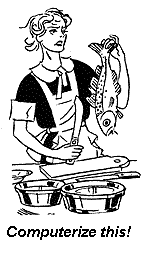DE GUSTIBUS
A Byte to Eat in the Kitchen of Tomorrow
Computers can organize recipes, but they
still can't cook.
BY JAMES TARANTO
The Wall Street Journal, Friday, January 14, 2000
LAS VEGAS--For decades, personal-computer makers have longed to put their products in America's kitchens. When the first PCs were mass-marketed in the 1970s, storing recipes was invariably cited as a potential application--perhaps in an effort to attract women to the world of computers.
This was a rather clumsy way of wooing the fairer sex, for storing recipes on, say, a 1977 Radio Shack TRS-80 was cumbersome, to say the least. You had to load a program from a cassette at the excruciating rate of 500 bits a second, type in your recipes, then switch to another cassette and save them. Retrieving them required a similar dual-tape operation. And no early PC was small enough to fit comfortably in the average kitchen. At the risk of sounding sexist, there is not a woman alive without the good sense to prefer index cards.
Today's woman is as likely to work for a high-tech company as to slave over a hot stove, but the quest for a computerized kitchen continues. At last weekend's Consumer Electronics Show here, Sun Microsystems turned a room in the Las Vegas Convention Center into what it called the ".com home," featuring kitchen appliances networked over the Internet. The command center is a "Web pad," a computer roughly the size of a notebook that is stored on the door of a Whirlpool refrigerator. The pad runs programs based on Sun's Java language; by touching its screen, you can control a variety of appliances, whose embedded computers also run Java programs. Even the coffeemaker is Java-based--no pun intended, I'm sure.
Yes, you can use Sun's system to store recipes. What's more, if you call up a recipe and don't have all the ingredients, you can touch the screen and add them to your shopping list. Then, when you get to the supermarket, you can view the list on a data-ready cellular phone. Another option is a handheld bar-code reader. Out of your favorite canned soup? Just scan the empty can to add it to the list.

Will such contraptions be as ubiquitous as the microwave oven come 2010? Maybe not. Seeing Sun's kitchen gadgets in action certainly prompts a gee-whiz response, but that's a far cry from a gee-whiz-I'm-going-to-buy-all-new-appliances response. Sure, Sun's networked kitchen is easy to use, unlike those old TRS-80s. But managing recipe files and shopping lists is not a particularly complicated or labor-intensive task to begin with, so the advantages of automation are dubious.
It's cooking that takes real work, and computers aren't much help here. But perhaps this will change when some more fanciful technologies make their way to the 21st-century kitchen. An Oakland, Calif., company called DigiScents was in Las Vegas promoting a device called iSmell, which, it says, allows users to retrieve odors from the Internet. DigiScents' technology analyzes the molecular structure of a smell and digitizes it into a short file. The user downloads the file and inhales as iSmell approximates the aroma by mixing any combination of 120 essential oils stored in a "scent cartridge."
Redmond, Wash.-based Conversa (pronounced conver-SAY), meanwhile, was at the show with a prototype of its software that aims at allowing users to talk with their computers. The voice-recognition technology is impressive; Conversa was able to identify my words without "training," the extensive sampling of a user's voice that earlier technology required. Its ability to make sense of the language, on the other hand, remains primitive. When I answered a yes-or-no question with "That is correct," Conversa ignored me.
Conversa CEO Steve Rondel has big dreams. He showed reporters a video dramatization of two women managing their hectic lives by using wireless headsets to talk with their computers from home, office and car. Using voice commands, they e-mailed documents to colleagues, got answers to fairly complicated questions about business matters, and even--now who's sexist?--asked for directions. The computer understood the commands in context and knew exactly what the women wanted.
This is the stuff of science fiction--literally. Mr. Rondel says his inspiration is the voice-operated computers on "Star Trek." He has based his marketing effort on the TV series, signing up a bevy of "Star Trek" actors as investors and spokesmen. Two of them, LeVar Burton and Kate Mulgrew, were on hand for a press conference Saturday, held at a mini-theme park in the Las Vegas Hilton called Star Trek: The Experience.
Now that computers have olfactory and auditory interfaces, can a gustatory one be far behind? Mr. Rondel seems a natural to develop it. On "Star Trek," after all, no one ever cooked. Food was supplied by a gizmo called a "replicator," which produced fully prepared dishes in seconds. One supposes that, like the DigiScents technology, the replicator employed molecular analysis to zap its delicacies into existence. Of course it was voice-activated: Computer. Lobster tail and filet mignon with drawn butter and bearnaise sauce. And a pint of Romulan Ale.
How about it, Mr. Rondel? If you build a replicator, no one will need Java in the kitchen. Better yet, no one will need a kitchen.
Next article: Elian's Journey (1/24/00)
Previous article: Extra! Extra! Journalists Gaze at Own Navels! (12/31/99)